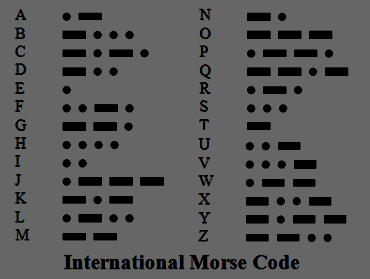CQ CQ – Mixed up Morse Code
|
Morse code is a method of transmitting textual information using a series of on/off signals of two different lengths — One long, and one short. The two signals are commonly referred to as dashes and dots. In well-formed Morse, the length of dash is three times the length of a dot, and gap equal to the length of a dot is left between each signal. |
 |
 |
The diagram to the left depicts the letter C. The faint vertical lines represent units of time. |
Each letter is represented by a unique sequence of dots and dashes. To separate each distinct letter a longer gap, equal to the length of a dash, is left at the end of each letter. An example is shown below for the word NICK. (A gap of seven dots is left between each word).

A potential problem arises if a sloppy Morse operator shortens the gap between each letter. If the gap becomes shorter and shorter, then eventually the inter-letter gap becomes indistinguishable from an intra-letter gap. When this happens, the message becomes a coalesced blob of dots and dashes.
Without the disambiguity provide by the inter-letter gap, the sequence of patterns can be interpreted in many different ways. A couple of possible examples are shown below:

In the example above the alternative interpretations are gobbledygook, but it’s not hard to see that it is possible to come up variants that are also real words.
As an example, five dots in a row ••••• could be interpreted as the word HE •••• • , or the word IS •• ••• , or the word SEE ••• • • (Also EH and SI)
Real Words
|
I was curious to find out just how many sloppy ambiguous Morse words there are in the English language. It turns out there are quite a lot more than I thought! In fact, there are so many that I’ve made a separate results page for all the 25,787 ambiguous words. This is made of 10,330 distinct Morse strings. The highest frequency ambiguous Morse word has 13 possible donor words (shown below). TSADI (5) , BABE (4) , BANS (4) , BATES (5) , BATH (4) , BEGS (4) , DIGS (4) , DIMES (5) , DEANS (5) , DEATH (5) , NEEPS (5) , NIPS (4) , DUNS (4) – • • • • – – • • • • You can view the entire results here! (Link opens in a new window). |
 |
WARNING – The word dictionary I used for this exercise is the same 174k word dictionary used in my Padlock Puzzle posting, and it contains some colourful language.
For instance did you know that the Morse strings for FUCKED and ELEMENTAL are the same • • – • • • – – • – • – • – • – • • ?
Morse Palindromes
I found 706 ambiguous Morse palindromes (Morse strings that read the same backwards as forwards), which create a total of 420 distinct dot/dash sequences. Here they are listed in descending order of length of the Morse string. Note - For many of the palindromes there is more than one English language solution. Also, when there is more than one solution, it does not mean the donor words are the same length.
|
An example of an ambiguous Morse palindrome is show below. This palindrome pattern is shared by four words. You can view the entire 706 solutions here (Link opens in a new window). ANTING (6) , ACETATE (7) , EQUATE (6) , WRAP (4) • – – • – • • – • – – • |
 |
Misc Trivia
The words below each have 20 dots in a row (the longest sequence of dots found in the words in my dictionary). It's also interesting to note the two of the three words have canonical spellings and in both of these cases, the Morse representations are the same!
BAKSHEESHES (11) , BAKSHISHES (10) – • • • • – – • – • • • • • • • • • • • • • • • • • • • •
DISSEISES (9) – • • • • • • • • • • • • • • • • • • • •
HASHEESHES (10) , HASHISHES (9) • • • • • – • • • • • • • • • • • • • • • • • • • •
|
The longest contiguous string of dashes is 15: BOTTOMMOST (10) – • • • – – – – – – – – – – – – – – – • • • – |
 |
|
Starting with a dash, the longest contiguous alternating sequece of dots and dashes can be found in this word ROCKETRY (8) • – • – – – – • – • – • – • – • – • – • – – |
 |
|
Starting with a dot, the longest contiguous alternating sequece of dots and dashes is: ARCKED (6) • – • – • – • – • – • – • – • • |
 |
You can find a complete list of all the articles here. Click here to receive email alerts on new articles.
Click here to receive email alerts on new articles.

